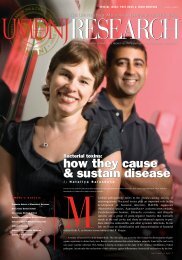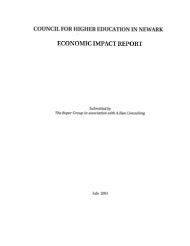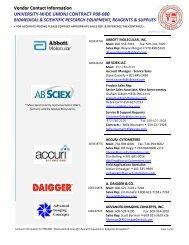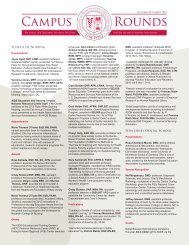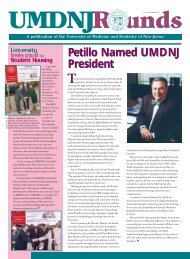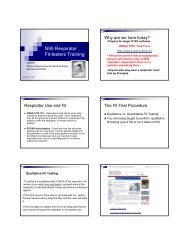Download as an Adobe PDF - University of Medicine and Dentistry ...
Download as an Adobe PDF - University of Medicine and Dentistry ...
Download as an Adobe PDF - University of Medicine and Dentistry ...
Create successful ePaper yourself
Turn your PDF publications into a flip-book with our unique Google optimized e-Paper software.
Skop’s ultimate<br />
goal is to use his<br />
scaffolds <strong>an</strong>d fetal<br />
stem cell line to<br />
regenerate the<br />
injured brain at<br />
the site <strong>of</strong> a severe<br />
injury.<br />
4 2 U M D N J M A G A Z I N E<br />
Europe — calling<br />
themselves the<br />
Tr<strong>an</strong>satl<strong>an</strong>tic Network<br />
on Newborn Stroke —<br />
who received a $6 million<br />
gr<strong>an</strong>t from the<br />
Paris-b<strong>as</strong>ed Fondation<br />
Leducq to investigate<br />
their premise that newborn<br />
brain injury may<br />
be reparable. His<br />
dream is to impact clinical<br />
practice with his<br />
lab’s findings within<br />
just a few years.<br />
Levison’s lab h<strong>as</strong><br />
demonstrated that brain injury in the inf<strong>an</strong>t stimulates the proliferation<br />
<strong>of</strong> stem cells within the “brain marrow,” resulting in a doubling<br />
<strong>of</strong> their number after just three days, <strong>an</strong>d that the new stem<br />
cells c<strong>an</strong> generate new neurons <strong>an</strong>d glia. What they are battling is a<br />
highly destructive c<strong>as</strong>cade <strong>of</strong> inflammatory molecules that is set <strong>of</strong>f<br />
at the time <strong>of</strong> trauma.<br />
Levison is also the principal investigator on a sizable gr<strong>an</strong>t<br />
from the New Jersey Commission on Brain Injury Research,<br />
which underwrites three collaborative projects at UMDNJ <strong>an</strong>d<br />
NJIT to devise strategies to enh<strong>an</strong>ce regeneration <strong>of</strong> brain cells<br />
<strong>an</strong>d to promote recovery <strong>of</strong> function after traumatic brain injuries<br />
(TBI). Cho <strong>an</strong>d G<strong>an</strong>dhi work with him on these projects.<br />
In May 2009, Skop beg<strong>an</strong> his research work on neural stem<br />
cells in G<strong>an</strong>dhi’s NJMS lab. His undergraduate degree had concentrated<br />
primarily on civil <strong>an</strong>d electrical engineering, so the doctoral<br />
student now focused on bolstering his knowledge <strong>of</strong> biology,<br />
specifically neurobiology, in order to delve headlong into medical<br />
research. “I took all four <strong>of</strong> the graduate stem cell cl<strong>as</strong>ses <strong>of</strong>fered<br />
plus a regenerative medicine cl<strong>as</strong>s,” he says. Skop earned a certificate<br />
in stem cell biology in 2010 <strong>an</strong>d also took on the presidency<br />
<strong>of</strong> the Stem Cell Education Society at UMDNJ.<br />
In G<strong>an</strong>dhi’s lab, he learned how to harvest stem cells from<br />
the subventricular zone <strong>of</strong> a healthy <strong>an</strong>imal <strong>an</strong>d tr<strong>an</strong>spl<strong>an</strong>t them<br />
adjacent to the damaged cerebral cortex <strong>of</strong> <strong>an</strong>other that is braininjured.<br />
The tr<strong>an</strong>spl<strong>an</strong>ted cells — glowing a fluorescent green —<br />
are e<strong>as</strong>ily distinguishable from the native cells.<br />
Skop h<strong>as</strong> worked with both fetal neural stem cells <strong>an</strong>d adult<br />
neural stem cells. “We tr<strong>an</strong>spl<strong>an</strong>ted both kinds after a fairly<br />
severe brain injury to see which would give the best results,” he<br />
says. “We were looking to see what the stem cells differentiated<br />
into <strong>an</strong>d the numbers <strong>of</strong> tr<strong>an</strong>spl<strong>an</strong>ted cells that survived.”<br />
Unfortunately, “very few <strong>of</strong> the cells survived the tr<strong>an</strong>spl<strong>an</strong>t,”<br />
he states, “which is in line with other research out there.”<br />
But since science is all about <strong>as</strong>king the right questions,<br />
Skop took the next step <strong>an</strong>d worked on framing the pivotal question<br />
for his research project. Could new engineering techniques<br />
— some <strong>of</strong> which he had recently learned in Cho’s biomedical<br />
engineering lab — be applied to improve the model <strong>an</strong>d consequently<br />
the outcomes?<br />
One <strong>an</strong>swer w<strong>as</strong> obvious: He needed to ab<strong>an</strong>don working on<br />
the adult stem cells because <strong>of</strong> their serious limitations <strong>an</strong>d<br />
concentrate on the fetal stem cells, which were showing far more<br />
promise for regeneration. The second <strong>an</strong>swer w<strong>as</strong> less obvious<br />
<strong>an</strong>d would dem<strong>an</strong>d further investigation: The stem cells needed<br />
to be placed differently in the cavity formed from the brain<br />
injury. “I started injecting the cells into the tissue surrounding<br />
the cavity but they weren’t migrating into the injured tissue to<br />
replace the damaged neurons,” the student explains.<br />
Skop w<strong>as</strong> on the right track, but not quite there. Tissue<br />
engineering is all about applying engineering principles, <strong>as</strong> well<br />
<strong>as</strong> knowledge <strong>an</strong>d skills in the life sciences, to develop new<br />
strategies to repair, <strong>an</strong>d new materials <strong>an</strong>d structures to replace,<br />
tissues <strong>an</strong>d even whole org<strong>an</strong>s that are no longer functional or<br />
viable. Stem cells, novel biomaterials, <strong>an</strong>d growth factors are used<br />
h<strong>an</strong>d-in-h<strong>an</strong>d with bioengineered structures — such <strong>as</strong> scaffolds<br />
— to support the growth <strong>of</strong> new tissue.<br />
Now the graduate student decided he w<strong>as</strong> ready to move<br />
forward with his doctoral project, using his engineering background<br />
to create a unique scaffold to promote the regeneration <strong>of</strong><br />
brain tissue. “My first step w<strong>as</strong> to optimize my scaffold, which<br />
turned out to be a lot <strong>of</strong> work. I’m still trying to improve it,” he<br />
explains.<br />
His idea w<strong>as</strong> that the scaffold would be multifunctional,<br />
serving <strong>as</strong> a delivery vehicle to get the stem cells to the right<br />
place, to provide a “hospitable” surface for the stem cells to grow<br />
on, <strong>an</strong>d, by attaching a growth factor to the scaffold, a me<strong>an</strong>s to<br />
enh<strong>an</strong>ce the growth <strong>an</strong>d survival <strong>of</strong> the newly introduced cells.<br />
The scaffold that Skop created in the NJIT lab—made <strong>of</strong><br />
microspheres <strong>of</strong> chitos<strong>an</strong> — is still being tested, but is “95 percent<br />
complete,” he says with a smile. One <strong>of</strong> his major hurdles<br />
w<strong>as</strong> to radically reduce the size <strong>of</strong> the microspheres in order to<br />
facilitate tr<strong>an</strong>spl<strong>an</strong>tation into the brain <strong>of</strong> the <strong>an</strong>imal model. With<br />
his engineering skills <strong>an</strong>d ingenuity, he accomplished his goal.<br />
He physically carries his mini scaffolds — small enough to fit<br />
in the palm <strong>of</strong> his h<strong>an</strong>d — on the CHEN bus linking the campuses<br />
<strong>of</strong> Newark’s major universities. They are “engineered” at<br />
NJIT but it is in the UMDNJ lab that he h<strong>as</strong> tested them with a<br />
fetal rat stem cell line. “It works!” he says proudly.<br />
Skop’s ultimate goal is to use his scaffolds <strong>an</strong>d fetal stem cell<br />
line to regenerate functional brain tissue at the site <strong>of</strong> a severe<br />
injury. “I w<strong>an</strong>t my work to be clinically relev<strong>an</strong>t,” he states.<br />
“We produce a cavity-type <strong>of</strong> brain injury, which causes cell<br />
death under the injured site. This area would normally scar, but<br />
the scaffold also provides a physical <strong>an</strong>d chemical barrier to the<br />
scarring process,” he explains.<br />
Skop sees this <strong>as</strong> the beginning <strong>of</strong> a “huge, very ambitious<br />
research project,” in which he will show that the stem cells c<strong>an</strong><br />
be tr<strong>an</strong>spl<strong>an</strong>ted at the site <strong>of</strong> the injury, survive, proliferate <strong>an</strong>d<br />
regenerate dead neurons. He hopes that in one year he will have<br />
some signific<strong>an</strong>t results to show.<br />
Rebuilding <strong>an</strong> injured region <strong>of</strong> the brain is among the most<br />
complex undertakings in the world <strong>of</strong> medical research. “The<br />
brain <strong>an</strong>d nervous system are difficult. People are afraid <strong>of</strong> this<br />
field,” says Skop, “If we are successful, our work will send ripples<br />
throughout the whole regenerative medicine community.”<br />
And that is just a glimpse <strong>of</strong> what one doctoral student with<br />
three supportive research mentors in two distinct specialties c<strong>an</strong><br />
accomplish when they put their heads together. .



